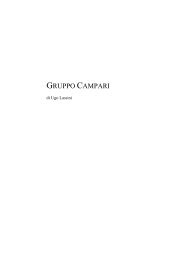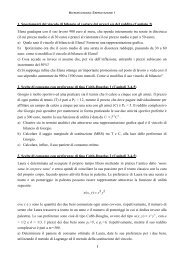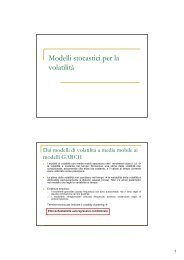Teoria della selezione del portafoglio e modelli di equilibrio del ...
Teoria della selezione del portafoglio e modelli di equilibrio del ...
Teoria della selezione del portafoglio e modelli di equilibrio del ...
Create successful ePaper yourself
Turn your PDF publications into a flip-book with our unique Google optimized e-Paper software.
) l’intensità <strong><strong>del</strong>la</strong> leva finanziaria <strong>di</strong>pende dal profilo<br />
( E( kroi) ; σ( kroi) ) = ( E( kroe) ; σ(<br />
kroe)<br />
) , con L = 0, <strong>del</strong> mix <strong>di</strong> business, scelto per<br />
leverare.<br />
σ(roe)<br />
2.25<br />
1.69<br />
c = 8<br />
17<br />
64<br />
Profilo<br />
ren<strong>di</strong>mento-rischio per l’azienda<br />
che voglia ulteriormente indebitarsi<br />
al tasso certo <strong>del</strong>l’8%<br />
Profilo (20, 2.25) per l’azienda che<br />
può indebitarsi a tasso certo 8%<br />
e voglia un L= 0.3333<br />
E(roe)<br />
Ren<strong>di</strong>mento rischio<br />
<strong>del</strong>l’azienda non leverata<br />
Fig. 26: L’azienda non indebitata che operi con un E(roe)=17%=E(roi) e<br />
σ(roe)=1.69%=σ(roi), avendo la possibilità <strong>di</strong> indebitarsi a tasso certo <strong>del</strong>l’8% se vuole<br />
un E(roe)=20% deve indebitarsi secondo: 8%(-L)+(1+L)17%=20% da cui L=0.3333.<br />
σ(roe) sarà: σ(roe)=σ(roi)(1+L)=1.69%⋅1.3333=2.2533%.<br />
Sostituendo (1+ k L ) con<br />
σ<br />
σ<br />
( k roe)<br />
( roi)<br />
k<br />
, la determinazione <strong>del</strong> valore atteso <strong>del</strong> roe <strong>di</strong>venta:<br />
( k roe)<br />
( roi)<br />
E( kroe) = c+ [ E( kroi)<br />
−c] k<br />
σ<br />
σ<br />
In questa espressione <strong>del</strong> valore atteso <strong>del</strong> roe <strong>del</strong> k-esimo mix <strong>di</strong> business, mix <strong>di</strong><br />
prodotti, d’azienda, il leverage kL non compare e si è <strong>di</strong>mostrato l'asserto a), concordando<br />
con quanto esposto da Mo<strong>di</strong>gliani-Miller52. 5.2.1 Scelte efficienti<br />
Valutiamo ora in quale <strong>portafoglio</strong> rischioso investire/produrre in modo efficiente. Le<br />
due determinazioni <strong>del</strong> valore atteso <strong>del</strong> roe viste sopra presuppongono <strong>di</strong> aver calcolato i<br />
parametri <strong><strong>del</strong>la</strong> frontiera efficiente dei business aleatori <strong>del</strong>l'azienda. Tale frontiera<br />
efficiente é ottenibile risolvendo il seguente problema <strong>di</strong> programmazione quadratica<br />
Eroe *<br />
, si cerca il <strong>portafoglio</strong> a<br />
( )<br />
parametrica in cui, fissato un roe atteso desiderato ( )<br />
rischio minimo:<br />
52 MODIGLIANI F., MILLER M., The cost of Capital,Corporation Finance and The Theory of Investment, in<br />
American Economic Review, June 1958;<br />
MODIGLIANI F., MILLER M., Dividend Policy, Growth and the Valuation of Shares, in Journal of Business,<br />
October 1961.
















